

Recherche par pays. Glottolog 3.3 - People Groups Official Web Site. Open Language Archives Community. UNESCO Atlas of the World's Languages in danger. Endangered Languages Project. Early_Localization_Native_Americans_USA.jpg (JPEG Image, 3850 × 2476 pixels) - Scaled (26%) Language Trainers USA Blog. Source: muturzikin.com I stumbled upon this fascinating site recently – muturzikin.com – the webmaster of which draws linguistic maps displaying different languages and dialects across continents.
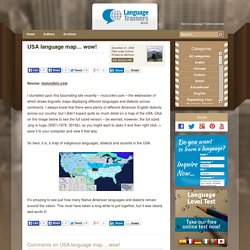
I always knew that there were plenty of different American English dialects across our country, but I didn’t expect quite so much detail on a map of the USA. Click on the image below to see the full sized version – be warned, however, the full sized .png is huge (3567×1878, 301Kb), so you might want to open it and then right click -> save it to your computer and view it that way. So here, it is, a map of indigenous languages, dialects and accents in the USA: It’s amazing to see just how many Native American languages and dialects remain around the nation.
TITUS Didactica: Language Map South America: Map frame. IndoEuropean Origins - GeoCurrents. Mismodeling Indo-European Origin and Expansion: Bouckaert, Atkinson, Wade and the Assault on Historical Linguistics Dear Readers, As GeoCurrents passed through its August slowdown, plans were made for a series on the Summer Olympics.
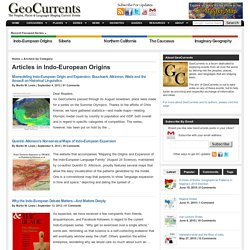
Thanks to the efforts of Chris Kremer, we have gathered statistics—and made maps—relating Olympic medal count by country to population and GDP, both overall and in regard to specific categories of competition. The series, however, has been put on hold by the … Quentin Atkinson’s Nonsensical Maps of Indo-European Expansion The website that accompanies “Mapping the Origins and Expansion of the Indo-European Language Family” (August 24 Science), maintained by co-author Quentin D. Why the Indo-European Debate Matters—And Matters Deeply As expected, we have received a few complaints from friends, acquaintances, and Facebook-followers in regard to the current Indo-European series.
The Hazards of Formal Geographical Modeling in Bouckaert et al. ISLRF : Institut Supérieur des Langues de la République Française. Langues européennes par famille linguistique. MultiTree. The Language Gulper. Nations sans État, minorités nationales, culturelles et linguistiques, peuples autochtones européens. Maps of the World and Worldwide Countries Maps. Guide to the Countries of the World. Nations sans État, minorités nationales, culturelles et linguistiques, peuples autochtones européens. Conférences vidéos. List of Languages - Languages In Danger. The Rosetta Project : archive all ducumented human languages project.
EBook : encyclopedia of the world's endangered languages. Atlas des langues en danger dans le monde. Middle East Maps. Middle East Maps The PCL Map Collection includes more than 250,000 maps, yet less than 30% of the collection is currently online.
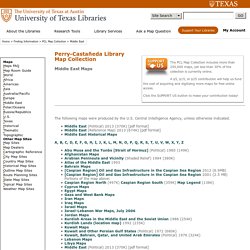
A $5, $15, or $25 contribution will help us fund the cost of acquiring and digitizing more maps for free online access. Click the SUPPORT US button to make your contribution today! The following maps were produced by the U.S. Central Intelligence Agency, unless otherwise indicated. Harvard Map Collection. The Gulf/2000 Project - SIPA - COLUMBIA UNIVERSITY. Maps and Statistics Collections All maps and their accompanying texts that are hosted by this Gulf/2000 web site are original, authored and produced by Dr.
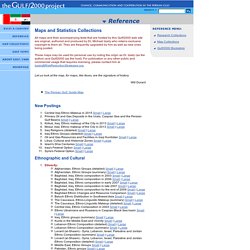
Michael Izady who retains exclusive copyright to them all. Languages of the World Map. Steve Huffman Language Maps. Dr.

Stephen Huffman Contents Abstract Dr. Language Hotspots. In the 21st century our planet’s natural resources have become endangered.

It is widely accepted that the biosphere—the sum total of the planet’s flora and fauna—is in great peril of collapsing as human populations make a massive impact on the natural world. But what is not widely known is that the human cultural “biosphere” —the sum total of all human cultures living on the planet today—is in even more peril. Over half of the 7,000 languages spoken in the world today are likely to disappear this century, and with them we will lose a wealth of knowledge about human history, culture, and the natural environment. Cartes linguistiques de Muturzikin. Survival International : e mouvement pour les peuples indigènes.
GDM : Groupement pour les Droits des Minorités. Organisation internationale de la Francophonie. Ethnologue. L'aménagement linguistique dans le monde: page d'accueil. SB Language Maps : geographic distribution of languages. Les principales langues du monde classées par familles. Les linguistes dénombrent environ 7 000 langues, auxquelles on peut ajouter des dizaines de milliers de dialectes.

Le classement ci-dessous (environ 800 langues) ne donne évidemment qu'un aperçu de cette immense variété. Pour retrouver une langue si vous ne connaissez pas sa famille, utilisez la fonction Edition, Rechercher de votre navigateur. Les langues éteintes n'ont généralement pas été citées. Attention, les chiffres sont donnés à titre indicatif et sont à prendre avec précaution. Si vous avez des informations plus fiables ou plus précises, ou que vous avez constaté des erreurs, n'hésitez pas à nous contacter. WALS Online : the world atlas of language structures.
Langues du monde, Linguistique LEXILOGOS. Sorosoro : pour que vivent les langues du monde. Endangered Languages Project. GELA : Grup d'Estudi de Llengües Amenaçades. El Grup d’Estudi de Llengües Amenaçades es va crear l’any 1992 amb l’objectiu de promoure la recerca en llengües amenaçades i donar a conèixer la diversitat lingüística i el seu valor.
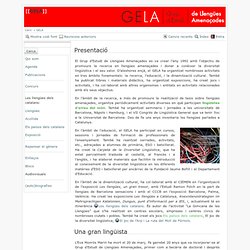
DELP - Papuan Languages. Somewhere close to a quarter of the total of the world's languages are spoken in the New Guinea region-about 1100 languages.
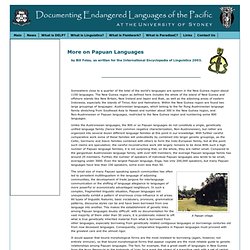
The New Guinea region as defined here includes the whole of the island of New Guinea and offshore islands like New Britain, New Ireland and Japen and Biak, as well as the adjoining areas of eastern Indonesia, especially the islands of Timor, Alor and Halmahera. Within the New Guinea region are found two large groupings of languages: Austronesian languages, which belong to the far flung Austronesian language family stretching from Southeast Asia to Hawaii and number about 300 in the New Guinea region, and Non-Austronesian or Papuan languages, restricted to the New Guinea region and numbering some 800 languages. It would appear that bound morphological forms are the most resistant to borrowing (again, however, not entirely immune), so that bound morphological forms that appear cognate are the most reliable guide to genetic relationships among Papuan languages. Endangered Languages of Indigenous Peoples of Siberia.
The Red Book of the Peoples of the Russian Empire. In the cliché-ridden propaganda of the Soviet era tsarist Russia was frequently dubbed the “prison of nations”.

When the Soviets came into power this “prison”, by virtue of new national policies, transformed into a family of friendly and brotherly nations in whose bosom all the national cultures flourished. To boast of the achievements under the Communist Party leadership, grandiose cultural festivals were arranged in the Soviet republics, folkloristic dance, song and instrumental groups were established and the revival of old peasant culture was encouraged. The slogan “socialist in content, nationalist in form” came to be applied to the new Soviet culture.
Native American Language Net: Preserving and promoting indigenous American Indian languages. MultiTree. Instituto Nacional de Lenguas Indígenas. Diversitat lingüística : la Casa de les Llengües. Lingva Prismo. List of languages by time of extinction. This is a list of extinct languages sorted by their time of extinction. When the exact time of death of the last remaining speaker is not known, either an approximate time or the date when the language was last being recorded is given. However, the list is not complete. 21st century[edit] 20th century[edit] 19th century[edit] 18th century[edit] 17th century[edit] Liste de langues mortes. Lists of endangered languages. In order to be listed, a language must be classified as "endangered" in an academic source quoted. SIL Ethnologue (2005) lists 473 out of 6,909 living languages inventorized (6.8%) as "nearly extinct", indicating cases where "only a few elderly speakers are still living"; this figure dropped to 6.1% as of 2013.[1] In order to judge if a language is endangered, the number of speakers is less important than the age distribution; There are languages in Indonesia reported with as many as two million native speakers alive now, but all of advancing age, with little or no transmission to the young.
On the other hand, while there are 30,000 Ladin speakers left, almost all children still learn it as their mother tongue, thus Ladin is not endangered in the 21st century. Extinct language. An extinct language is a language that no longer has any speakers,[1] or that is no longer in current use. Extinct languages are sometimes contrasted with dead languages, which are still known and used in special contexts in written form, but not as ordinary spoken languages for everyday communication. However, language extinction and language death are often equated. Language loss[edit] List of languages by time of extinction. Langues en voie de disparition. Un article de Wikipédia, l'encyclopédie libre.
Category:Extinct languages of North America. Category:Extinct languages of South America. Category:Extinct languages of Australia. Liste de langues. Un article de Wikipédia, l'encyclopédie libre. Cet article constitue une liste regroupant par ordre alphabétique les langues nationales et construites. Les familles de langues ne sont pas dans cette liste, sauf s'il s'agit à la fois d'une langue et d'une famille de langue. Par exemple, on n'y trouvera pas l'ibéro-roman car c'est une famille de langues. En revanche, y figure l'indo-européen, car c'est une langue morte (même hypothétique) qui est devenue une famille de langues. Langues du monde, Linguistique LEXILOGOS.